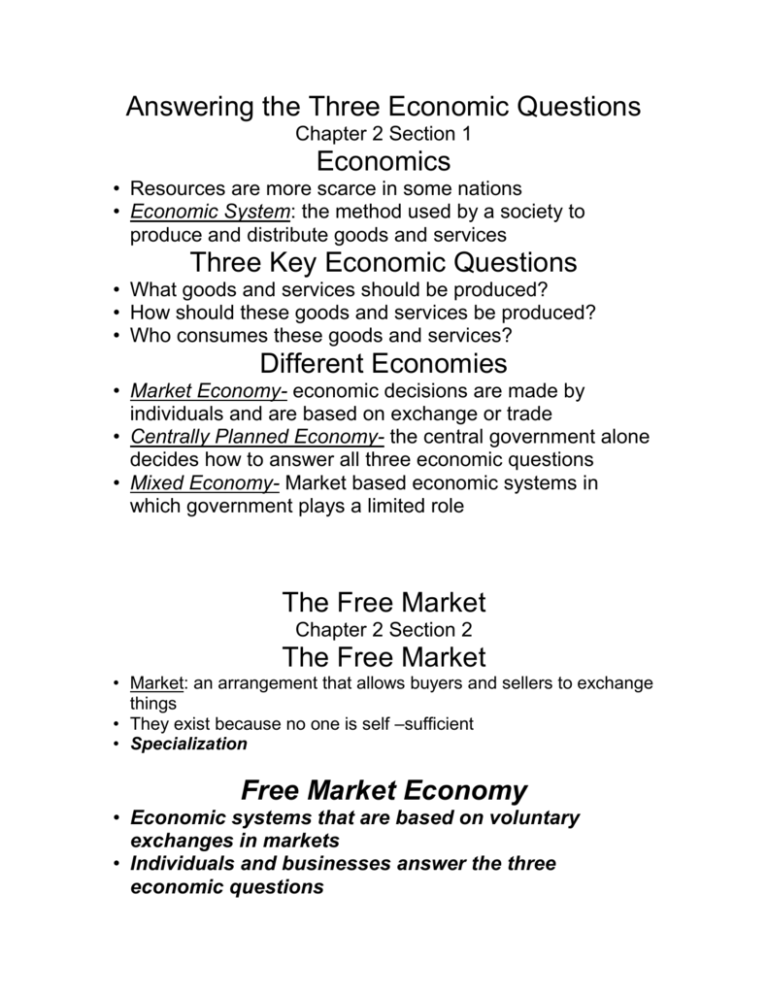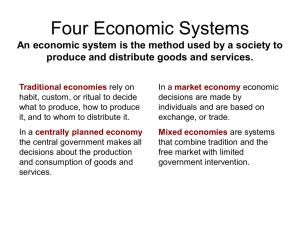Answering the Three Economic Questions
advertisement

Answering the Three Economic Questions Chapter 2 Section 1 Economics • Resources are more scarce in some nations • Economic System: the method used by a society to produce and distribute goods and services Three Key Economic Questions • What goods and services should be produced? • How should these goods and services be produced? • Who consumes these goods and services? Different Economies • Market Economy- economic decisions are made by individuals and are based on exchange or trade • Centrally Planned Economy- the central government alone decides how to answer all three economic questions • Mixed Economy- Market based economic systems in which government plays a limited role The Free Market Chapter 2 Section 2 The Free Market • Market: an arrangement that allows buyers and sellers to exchange things • They exist because no one is self –sufficient • Specialization Free Market Economy • Economic systems that are based on voluntary exchanges in markets • Individuals and businesses answer the three economic questions • Functions best in a democracy • Circular flow model (p.30) Adam Smith • Wealth of Nation • Influenced western economies Competition • Incentive: the hope of reward that encourages a person to behave a certain way • Competition: struggle among producers for the dollars of consumers • The Invisible Hand: term economists use to describe the self-regulating nature of the market place Centrally Planned Economy Chapter 2 Section 3 Centrally Planned Economies • Opposite of a Free Market Economy • Oppose private property, free market pricing, competition, and consumer choice • The Central Government answer the three economic questions, rather than the individual – What to produce – How much – How much to charge Socialism • A social / political philosophy based on the belief that democratic means should be used to distribute wealth • Only possible if the public controls the economic power • Government often owns factories and large industries Communism • Arose from the philosophy of socialism • Centrally planned economy • All power lies with the central government • Believe a socialist society can only come after a violent revolution • Authoritarian Communism The Former Soviet Union • • • • Began 1917 Central planning was introduced in the 1920s Most concerned with power- most resources went to military Broke Up in 1991 Soviet Agriculture • • • • Large state owned farms Farmers worked for daily wages set by the farmer Collectives- large farms leased from the state to peasant farmers Required to produce what the government tells them to Soviet Industry • • • • Factories-state owned Most resources used for the military Little resources left for other needs Lack of incentives Soviet Consumers • Who cares? – Guaranteed a job • “We pretend to work, they pretend to pay us” • Long Lines • Very little luxury Problems with this Economy • Poor Quality • Serious Shortages • Diminishing Production Modern Economies Chapter 2 Section 4 The Rise of Mixed economies • There are no longer any economies that are completely free market or centrally planned Limits of Laissez-Faire • Both centrally planned and free market economies have drawbacks • Adam Smith: Laissez faire (the idea that the government should not intervene in the market place) • Since Smith, government has become more involved in the economy Limits of Laissez-Faire • How well could the market place provide for national defense or roads? • Government create laws protecting property rights and enforcing contracts Comparing Mixed Economies • Compare the charts on P. 30 & 42 • The foundation of the US economy is the free market • Free Enterprise: ownership and investments are held by individuals or corporations • Continuum of Mixed Economies – (p. 43…Where do we fall?) Ends of the Spectrum • North Korea’s government owns all property, and 95% of economic output • Hong Kong’s government protects private property, and rarely interferes in the free market The U.S. Economy • Free enterprise economy…but the government intervenes to keep order, provide services, and promote general welfare • US laws protect private property











